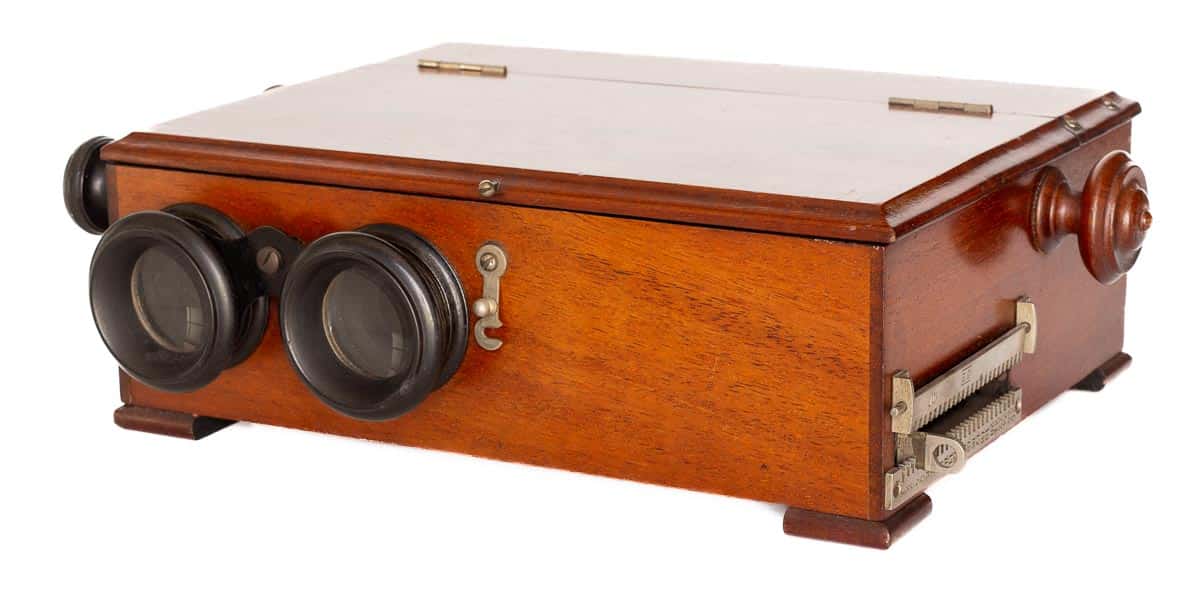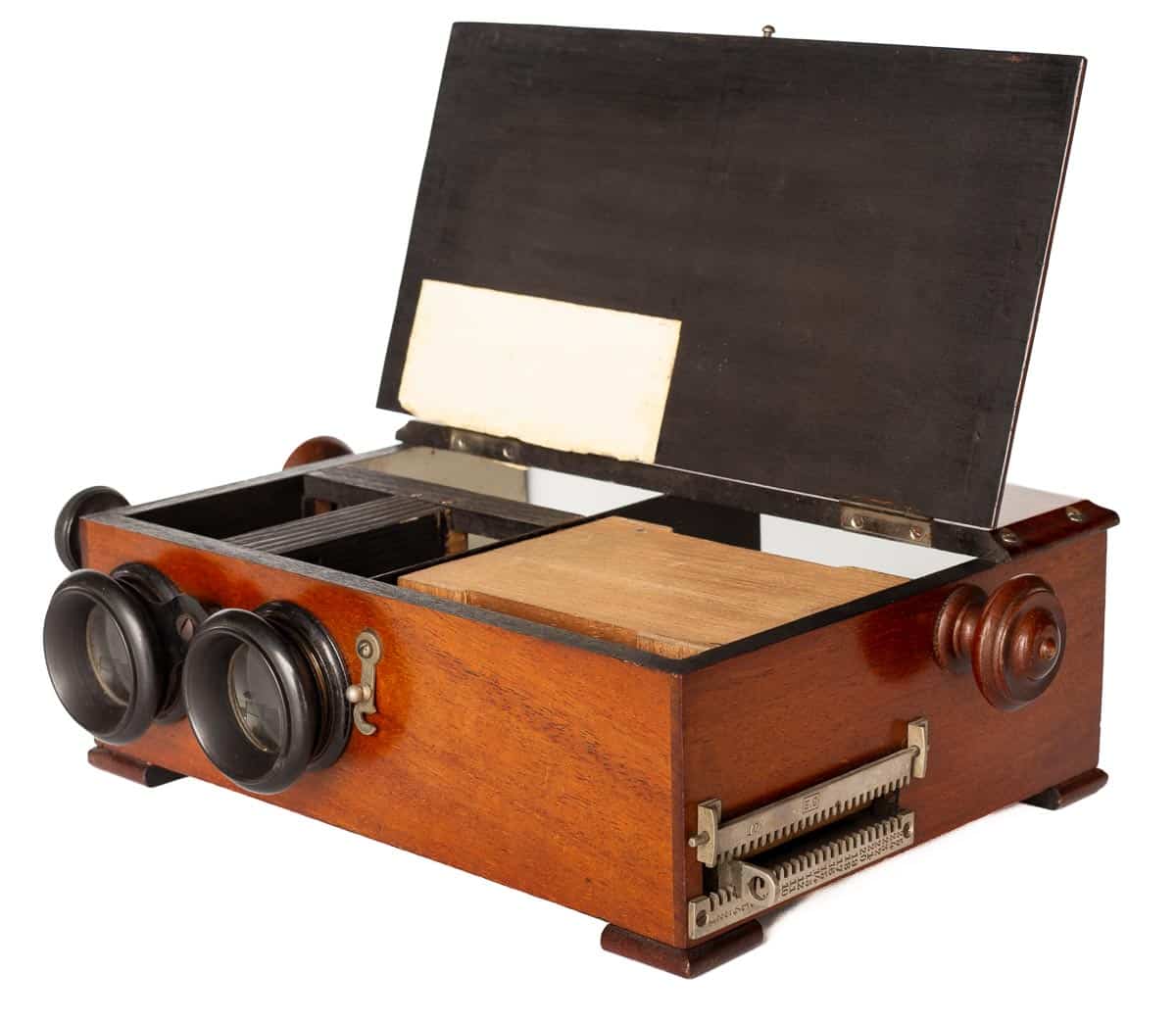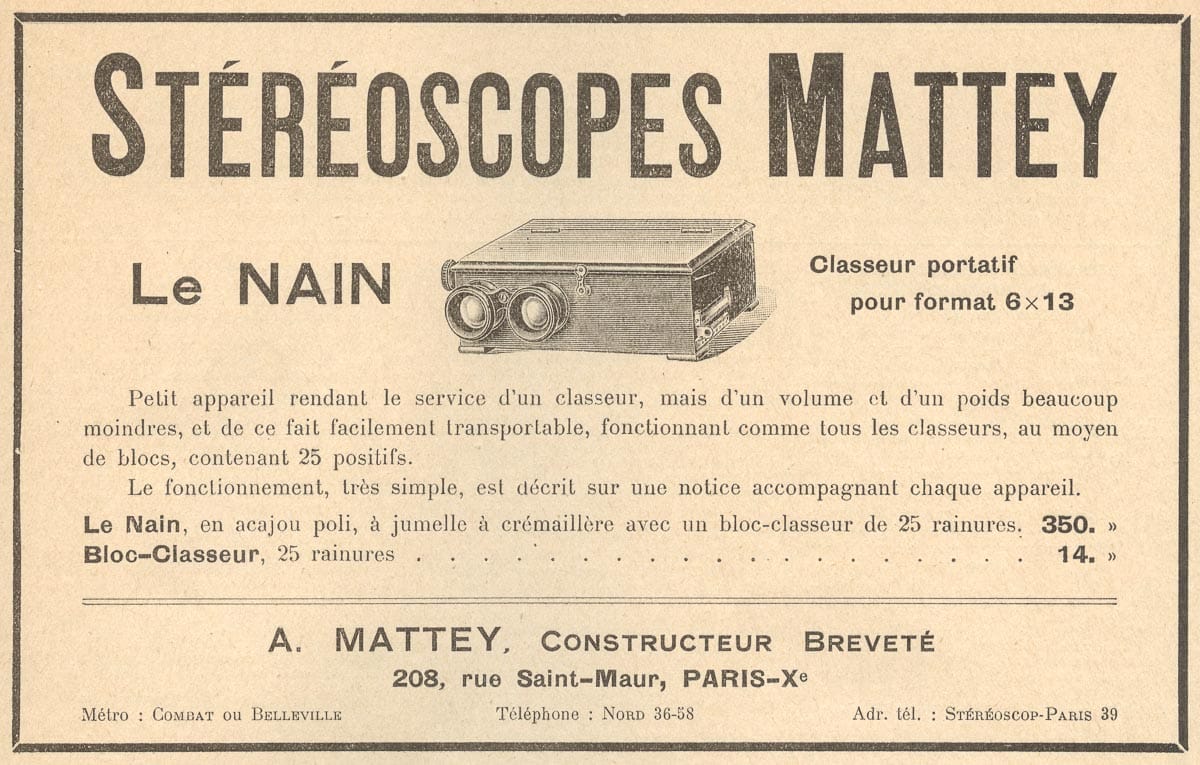
Le Nain is a curious viewer for glass stereoviews. “Le Nain” means dwarf in French, and it emphasises the compact design of the stereoscope. The idea behind the design is explained in the Mattey catalogue from 1922:
The current multi-view stereoscopes are robust devices consisting of a multi-view mechanism and a storage cabinet for 200 to 300 views. These stereoscopes, which are good to be placed on a table, are very practical for viewing large numbers of stereoviews, but cannot be easily moved because of their weight. It is therefore interesting to have a small multi-view stereoscope, but of much less volume and weight. “Le Nain” was built to fill this gap as it is a small handheld viewer receiving 25 glass slides stored in a tray, which is almost similar to that of the “Stéréothèque”.
A small lever on the right side of Le Nain is placed between two metal strips with teeth. Pushing the lever up and forward moves the tray forward over a rail, and a glass slide is brought into position. The whole device must be turned counter-clockwise so that the glass slide falls out of the tray by gravity and is placed in front of the lenses. When the device is turned clockwise, the slide falls back into the tray. The next image can then be selected with the lever. The design avoids the need for an advanced mechanism and keeps the design relatively compact. In practice, this procedure works quite well, though it is a bit cumbersome.
The design, based on falling motion, was described in a patent by Émile Moonen and Mattey from 19041. Le Nain for the 45 x 107 mm format was discontinued in the 1920s and the device didn’t appear in the Mattey 1927 catalogue. It is remarkable that Le Nain was reintroduced in 1930, but only for the 6 x 13 cm format2.

Specifications
| Manufacturer: | Mattey |
| Year of introduction: | c. 1904 |
| Year of manufacture: | c. 1904–c. 1925 |
| Type: | Hand-held |
| Viewer: | Multi-view |
| Mechanism: | Tray-based |
| Bidirectional navigation: | No |
| Serial number: | None |
| Stereoview support: | Glass |
| Stereoview format: | 45 x 107 mm |
| Number of slides: | 25 |
| Lens focussing: | Yes |
| Inter-ocular adjustment: | No |
| Eyepiece blinders: | No |
| Dimensions (L x W x H): | 24 x 17.5 x 8.5 cm |
| Construction: | Mahogany |
| Other features: | Contains Pennard & Fouquet logo Includes a wooden slide tray |
Patent
| Number: | FR341928 |
| Title: | Perfectionnements aux appareils pour l’examen ou la projection de vues photographiques |
| Filing date: | 10-02-1904 |
| Publishing date: | 23-08-1904 |
| Applicant(s): | Émile Moonen, Mattey Père et Fils |

La Revue Française de Photographie, 15 June 1930.
Glossary: hand-held / inter-ocular adjustment / single-view
Mattey
Mattey was one of the leading manufacturers of stereoscopes in France. The company offered the widest range of stereoscopes of all manufacturers. The company was founded in 1872, but its expansion began with the establishment of Société Mattey père et fils on 31 December 1902. The names behind the company were André Élie Victor Mattey (1844–1919), and his son Albert Georges Mattey (1873–1940). Mattey’s business grew through acquisitions. The most important was the acquisition of Maison Legendre in 1902, which set the foundation for Mattey’s stereoscope business.
Société Mattey père et fils was dissolved on 1 January 1912, and the company was continued by Albert Georges as Stéréoscopes A. Mattey. The company was located at 208, Rue Saint-Maur in Paris from 1906 but moved to 15, Rue Clavel in 1936. After the Second World War, the company continued as Société des Anciens Établissements A. Mattey. Mattey’s products were also branded Unis France, a collective trademark to guarantee the French origin of high-quality products, made by different companies.
The complete story of Mattey
References
- Moonen, E., Mattey Père et Fils (1904) Perfectionnements aux appareils pour l’examen ou la projection de vues photographiques. Via: data.inpi.fr ↩︎
- Petit Communiqué sur les Nouveautés Photographiques, L’Instantané (1930). Via: data.inpi.fr ↩︎
